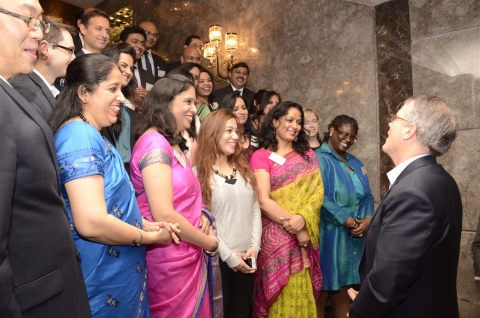Feb192016
Posted at 10:13 AM
U.S. Deputy Secretary of Commerce Bruce Andrews traveled last week to India, where he led a delegation of 18 American companies on a Smart Cities Infrastructure Business Development Mission. The delegation focused on systems, technologies and services that can support sustainable growth of India’s infrastructure, including safety and security, intelligent transportation, water, wastewater, and clean energy, among other sectors. The mission accomplished a key deliverable announced during President Obama’s meeting with Prime Minister Modi in January 2015 and later cemented during the Strategic & Commercial Dialogue this past September.
Prime Minister Modi’s leadership in revitalizing India’s economic development and his vision to develop 100 smart cities can enhance the quality of life for India’s citizens and help India meet its environmental goals. The smart cities plan, which involves the overlaying of urban infrastructure with IT connectivity, can improve core infrastructure and enhance citizen services. It can also offer a unique and important opportunity for American businesses.
During the mission, Deputy Secretary Andrews highlighted the need for India to address the fundamental ‘ease of doing business’ barriers that have traditionally hampered expanded trade and investment between our two countries. He also showcased the valuable contribution that U.S. industry can play in providing the products and services India’s cities need to become global leaders in the deployment of “smart” technologies.
India’s Smart Cities Challenge began in June 2015 with the selection of 100 smart cities that were invited to submit competitive plans for deploying capital in support of smart infrastructure development. The week before the trade mission arrived in India, Prime Minister Modi’s government named the first 20 cities that will be provided $15 million annually for the next five years as seed money to facilitate “smart cities” updates and improvements. The national government’s investment will be matched by state governments and used to catalyze private-sector investment.
Visakhapatnam (Vizag), one of the three initial smart cities named as an official partner for the United States, was included in the initial 20 cities that received funding. As an awardee of the Smart Cities Challenge, financing of Vizag’s development and modernization efforts will be partially supported by the central government of the Republic of India.
As part of the trade mission, U.S. Trade and Development Agency Director Leocadia Zak concluded a grant agreement in the presence of Chief Minister N. Chandrababu Naidu of the State Government of Andhra Pradesh to continue USTDA’s support of India’s ambitious goal of developing smart cities across the country. The agreement will advance the City of Vizag’s efforts to make it more efficient and sustainable through the development of interconnected infrastructure, communications and data systems.
Why Smart Cities in India?
Over the next two decades, it is expected that over 300 million people will move into Indian cities – roughly the entire population of the United States. The decisions Indian policy-makers make today about how to address this mass migration will dramatically impact the world’s ability to solve complex global challenges like climate change.
Deputy Secretary Andrews highlighted these challenges – as well as the opportunities for India’s global leadership on smart cities – during his keynote remarks in Chennai at the Indo-American Chamber of Commerce (IACC) Conference titled “Smart Cities – the Way Ahead.” His remarks highlighted how the United States can be a valuable partner in helping India create a new, green economy.
Deputy Secretary Andrews also met with the Confederation of Indian Industry, as well as officials from the government of Tamil Nadu to discuss how the United States is supporting private sector and Smart Cities initiatives in Indian states. He noted that many states in the United States are driving advances in our clean tech industry and urged state governments in India to demonstrate to their citizens the business opportunity of deploying climate-friendly, smart cities technologies.
What’s Next
This mission was part of a broad, comprehensive U.S. public-private sector approach to working with India. The U.S. Department of Commerce’s offices in India, in partnership with the American Chamber of Commerce and local commercial chambers, continues to help lay the groundwork for proposed smart city projects throughout India.
Through continued engagement under the Strategic and Commercial Dialogue, Infrastructure Collaboration Platform, and other initiatives, the Commerce Department is confident that the U.S.- India relationship can become even stronger in the months and years ahead and move closer to its potential. We are committed to partnering with India to achieve $500 billion in balanced two-way trade.
Learn more about this trade mission, and read about other highlights of the Deputy Secretary’s trip, including his visit to IBM’s Customer Experience Center in Delhi and his keynote remarks at the 3rd Smart Cities Summit in Mumbai.




